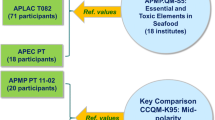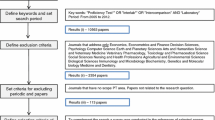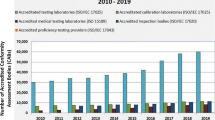Abstract
The two most important concepts in metrology are certainly “traceability to standards” and “measurement uncertainty evaluation”. So far the questions related to these concepts have been reasonably solved in the metrology of “classical quantities”, but for the introduction of metrological concepts in new fields, such as chemistry and biology, a lot of problems remain and must be solved in order to support international arrangements. In this presentation, the authors want to develop the strategy implemented at Laboratoire national de métrologie et d’essais (LNE) in metrology in chemistry and biology. The strategy is based on: (1) pure solutions for calibration of analytical instruments, (2) use of certified reference materials (matrix reference materials), and (3) participation to proficiency testing schemes. Examples will be presented in organic and inorganic chemistry. For laboratory medicine, proficiency testing providers play an important role in the organization of External Quality Assessment Schemes. For the time being, the reference value or the assigned value of the comparison is calculated with the results obtained by the participants. This assigned value is not often traceable to SI units. One of the methods suggested by LNE is to ensure the metrological traceability to SI units of the assigned value for the more critical quantities carried on analytes by implementing the Joint committee for traceability in laboratory medicine reference methods.


Similar content being viewed by others
References
International Vocabulary of Metrology—basic and general concepts and associated terms. JCGM 200: 2008: http://www.bipm.org/utils/common/documents/jcgm/JCGM_200_2008.pdf
Milton MJT, Quinn TJ (2001) Metrologia 38:289–296. doi:10.1088/0026-1394/38/4/1
Majors RE (1991) LC–GC Int 4:10
Vial J, Le Mapihan K, Jardy A (2002) Bio-forum Int Ed Fr 2:18
Quevauviller P (2004) Trends Analyt Chem 23:171. doi:10.1016/S0165-9936(04)00314-0
Emons H, Linsinger TPJ (2003) Trends Analyt Chem 23:442. doi:10.1016/S0165-9936(04)00604-1
Institut français de l’environnement (2000) In: IFEN (eds) Etudes et Travaux IFEN, ‘‘les pesticides dans les eaux’’. IFEN, Orleans
Deplagne J, Vial J, Pichon V, Hennion M-C, Lalere B, Hervouet G (2006) J Chromatogr A 1123:31. doi:10.1016/j.chroma.2006.04.085
NF ISO 5725 standard (1994) Accuracy (trueness and precision) of measurement methods and results. Internal Organization for Standardization, Geneva
Eurachem/Citac guide CG4 (2000) In: Ellison SLR, Rosslein M, Williams A (eds) Quantifying uncertainty in analytical measurement, 2nd edn. United Kingdom
Vial J, Ménier I, Jardy A, Anger P, Brun A, Burbaud L (1998) J Chromatogr B Analyt Technol Biomed Life Sci 708:131. doi:10.1016/S0378-4347(97)00668-3
ISO/CEI 17025 standard (2005) General requirements for the competence of testing and calibration laboratories. International Organization for Standardization, Geneva
Cofrac Guide d’évaluation des incertitudes de mesure des analyses de biologie médicale Doc LAB GTA 14 Novembre 2006
Fisicaro P, Amarouche S, Lalere B, Labarraque G, Priel M (2008) Accred Qual Assur 13:361–366. doi:10.1007/s00769-008-0402-x
Thompson M, Ellison SLR, Wood R (2006) The international harmonized protocol for the proficiency testing of analytical chemistry laboratories (IUPAC Technical Report). Pure Appl Chem 78:145–196. doi:10.1351/pac200678010145
Priel M, Amarouche S, Désenfant M, De Graeve J (2008) Using proficiency testing results latest alternative method for uncertainty evaluation: application in clinical chemistry. Transverse disciplines in metrology. In: Proceedings of the 13th international metrology congress (Publication ISTE)
Author information
Authors and Affiliations
Corresponding author
Rights and permissions
About this article
Cite this article
Priel, M., Amarouche, S. & Fisicaro, P. Metrological traceability is not always a straight line. Accred Qual Assur 14, 593–599 (2009). https://doi.org/10.1007/s00769-009-0540-9
Received:
Accepted:
Published:
Issue Date:
DOI: https://doi.org/10.1007/s00769-009-0540-9




